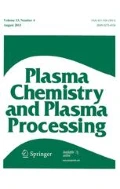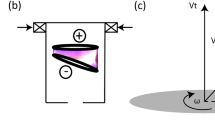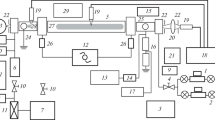Abstract
Carbon dioxide decomposition in a micro-slit sustained glow discharge reactor operated at low pressure of 8 Torr was studied experimentally. A specially designed reactor with a micro-slit configuration, combined with a third electrode that allows the extraction of electrons from the micro-slit discharge, was used to extend the glow discharge volume of the micro-slit discharge. It is found that, with the increase of the applied voltage of the third electrode, both the conversion fraction and energy efficiency of CO2 decomposition increase. The three-electrode structure was also extended to parallel operation to investigate the effects of applied voltage, flow rate, and number of parallel units on the conversion fraction and energy efficiency of CO2 decomposition. A maximum energy efficiency of 7.2% was achieved at a flow rate of 30 ml/min and power of 2.1 W for a single discharge unit, while for three discharges units connected in parallel, the maximum conversion fraction was 26.2% at a flow rate of 2 ml/min and power of 6.6 W. The results demonstrate the feasibility of parallel operation of the three-electrode micro-slit discharges, and increasing the number of parallel discharges increases both energy efficiency and conversion fraction at high flow rates. A better understanding of the physical and chemical kinetic processes will lead to optimization of future reactors to improve conversion and energy efficiency.










Similar content being viewed by others
References
Ashford B, Xin T (2017) Non-thermal plasma technology for the conversion of CO2. Curr Opin Green Sustain Chem 3:45–49
Moroz VI (1976) The atmosphere of Mars. Space Sci Rev 19(6):763–843
Muscatello AC, Santiagomaldonado E (2012) Mars in situ resource utilization technology evaluation. In: AIAA Aerospace Sciences Meeting Including the New Horizons Forum and Aerospace Exposition
Paulussen S, Verheyde B, Tu X et al (2010) Conversion of carbon dioxide to value-added chemicals in atmospheric pressure dielectric barrier discharges. Plasma Sources Sci Technol 19(3):34015–34016
Duan X, Li Y, Ge W et al (2015) Degradation of CO2 through dielectric barrier discharge microplasma. Greenhouse Gases Sci Technol 5(2):131–140
Mei D, He Y, Liu S (2016) Optimization of CO2 conversion in a cylindrical dielectric barrier discharge reactor using design of experiments. Plasma Process Polym 13(5):544–556
Spencer LF, Gallimore AD (2013) CO2 dissociation in an atmospheric pressure plasma/catalyst system: a study of efficiency. Plasma Sources Sci Technol 22(1):015019
Chen G, Britun N, Godfroid T et al (2017) An overview of CO2 conversion in a microwave discharge: the role of plasma-catalysis. J Phys D Appl Phys 50(8):084001
Indarto A, Yang DR, Choi JW et al (2007) Gliding arc plasma processing of CO2 conversion. J Hazard Mater 146(1):309–315
Nunnally T, Gutsol K, Rabinovich A et al (2011) Dissociation of CO2 in a low current gliding arc plasmatron. J Phys D Appl Phys 44(27):274009
Schoenbach KH, Verhappen R, Tessnow T et al (1996) Microhollow cathode discharges. Appl Phys Lett 68(1):13–15
Moselhy M, Schoenbach KH (2004) Excimer emission from cathode boundary layer discharges. J Appl Phys 95(4):1642–1649
Becker KH, Godfrey BB, Kunhardt EE et al (2015) Robert barker memorial session: leadership in plasma science and applications. IEEE Trans Plasma Sci 43(4):914–936
Tirumala R, Li Y, Pohlman DA (2011) Corona discharges in sub-millimeter electrode gaps. J Electrostat 69(1):36–42
Hensel K, Machala Z, Tardiveau P (2009) Capillary microplasmas for ozone generation. Eur Phys J Appl Phys 47(2):1–5
Sousa JS, Bauville G, Puech V (2013) Arrays of microplasmas for the controlled production of tunable high fluxes of reactive oxygen species at atmospheric pressure. Plasma Sources Sci Technol 22(3):035012
Shimizu T, Sakiyama Y, Graves DB et al (2012) The dynamics of ozone generation and mode transition in air surface micro-discharge plasma at atmospheric pressure. New J Phys 14(10):103028
Elhabachi A, Shi W, Moselhy M et al (2000) Series operation of direct current xenon chloride excimer sources. J Appl Phys 88(6):3220–3224
Zhu W, Takano N, Schoenbach KH et al (2007) Direct current planar excimer source. J Phys D Appl Phys 40(40):3896
Kurunczi P, Martus KE, Becker K (2003) Neon excimer emission from pulsed high-pressure microhollow cathode discharge plasmas. Int J Mass Spectrom 223(02):37–43
Mariotti D, Sankaran RM (2010) Microplasmas for nanomaterials synthesis. J Phys D Appl Phys 43(43):241–323001
Shimizu Y, Sasaki T, Bose AC et al (2006) Development of wire spraying for direct micro-patterning via an atmospheric-pressure UHF inductively coupled microplasma jet. Surf Coat Technol 200(14–15):4251–4256
Becker K, Koutsospyros A, Yin SM et al (2005) Environmental and biological applications of microplasmas. Plasma Phys Control Fusion 47(47):B513
Koutsospyros AD, Yin SM, Christodoulatos C et al (2005) Plasmochemical degradation of volatile organic compounds (VOC) in a capillary discharge plasma Reactor. IEEE Trans Plasma Sci 33(1):42–49
Panikov NS, Paduraru S, Crowe R et al (2002) Destruction of Bacillus subtilis cells using an atmospheric-pressure capillary plasma electrode discharge. IEEE Trans Plasma Sci 30(4):1424–1428
Iza F, Kim GJ, Lee SM et al (2008) Microplasmas: sources, particle kinetics, and biomedical applications. Plasma Process Polym 5(4):322–344
Lindner PJ, Sang YH, Besser RS (2013) Analysis of a microplasma fuel reformer with a carbon dioxide decomposition reaction. Energy Fuels 27(8):4432–4440
Ma T, Wang HX, Shi Q et al (2018) Breakdown and current–voltage characteristics of DC micro-slit discharges in carbon dioxide. Plasma Sources Sci Technol 27(7):075011
Taylan O, Berberoglu H (2015) Dissociation of carbon dioxide using a microhollow cathode discharge plasma reactor: effects of applied voltage, flow rate and concentration. Plasma Sources Sci Technol 24(1):015006
Hsu DD, Graves DB (2005) Microhollow cathode discharge reactor chemistry. Plasma Chem Plasma Process 25(1):1–17
Stark RH, Schoenbach KH (1999) Direct current high-pressure glow discharges. J Appl Phys 85(4):2075–2080
Stark RH, Schoenbach KH (1999) Direct current glow discharges in atmospheric air. Appl Phys Lett 74(25):3770–3772
Mohamed AAH, Block R, Schoenbach KH (2002) Direct current glow discharges in atmospheric air. IEEE Trans Plasma Sci 30(1):182–183
Sousa JS, Puech V (2011) Pressure effects in the spatial development of microcathode sustained discharges in rare-gas oxygen mixtures. IEEE Trans Plasma Sci 39(11):2680–2681
Sousa JS, Bauville G, Lacour B (2010) DNA oxidation by singlet delta oxygen produced by atmospheric pressure microdischarges. Appl Phys Lett 97(14):81
Shin J, Rahman MT (2011) Formation of microhollow cathode sustained discharge with split third electrodes. IEEE Trans Plasma Sci 39(11):2676–2677
Sharmin S, Jichul S (2014) Dynamic characteristics of a microhollow cathode sustained discharge with split third electrodes for potential flow application to flow velocimetry. Chin Phys Lett 31(09):107–110
Schoenbach KH, Moselhy M, Shi WH (2004) Self-organization in cathode boundary layer discharges. Plasma Sources Sci Technol 13(2):S177–S185
Takano N, Schoenbach KH (2006) Self-organization in cathode boundary layer discharges in xenon. Plasma Sources Sci Technol 15(2):S109–S117
Callegari T, Aubert X, Rousseau A, Boeuf JP, Pitchford LC (2010) Microhollow cathode sustained discharges: comparative studies in micro- and equivalent macro-cell geometries. Eur Phys J D 60(3):581–587
Park HI, Lee TI, Park KW (2003) Formation of large-volume, high-pressure plasmas in microhollow cathode discharges. Appl Phys Lett 82(19):3191–3193
Aerts R, Somers W, Bogaerts A (2015) Carbon dioxide splitting in a dielectric barrier discharge plasma: a combined experimental and computational study. Chemsuschem 8(4):702–716
Dong L, Ran J, Mao Z (2005) Direct measurement of electron density in microdischarge at atmospheric pressure by Stark broadening. Appl Phys Lett 86(16):1400
Qi B, Huang J, Gao L (2009) Electron density measurements in an atmospheric pressure argon discharge by means of plasma radiation. Phys Plasmas 16(8):230
Shrestha R, Tyata RB, Subedi DP (2013) Effect of applied voltage in electron density of homogeneous dielectric barrier discharge at atmospheric pressure. Himal Phys 4(4):10–13
Mei D, Tu X (2017) Conversion of CO2 in a cylindrical dielectric barrier discharge reactor: effects of plasma processing parameters and reactor design. J CO2 Util 19:68–78
Ramakers M, Michielsen I, Aerts R et al (2015) Effect of Argon or Helium on the CO2 conversion in a dielectric barrier discharge. Plasma Process Polym 12(8):755–763
Bongers W, Bouwmeester H, Wolf B (2017) Plasma-driven dissociation of CO2 for fuel synthesis. Plasma Process Polym 14:1600126
Aerts R, Snoeckx R, Bogaerts A (2014) In-situ chemical trapping of oxygen in the splitting of carbon dioxide by plasma. Plasma Process Polym 11(10):985–992
Wang Q, Yan BH, Jin Y (2009) Investigation of dry reforming of methane in a dielectric barrier discharge reactor. Plasma Chem Plasma Process 29(3):217–228
Gutsol A, Rabinovich A, Fridman A (2011) Combustion-assisted plasma in fuel conversion. J Phys D Appl Phys 44(27):274001
Khassin AA, Pietruszka BL, Heintze M (2004) The impact of a dielectric barrier discharge on the catalytic oxidation of methane over Ni-containing catalyst. React Kinet Catal Lett 82(1):131–137
He SJ, Zhang Z, Zhao XN, Li Q (2017) Spatio-temporal characteristics of microhollow cathode sustained discharge. Acta Phys Sin 66(5):055101
He SJ, Jing H, Zhang Z, Ouyang J, Li Q (2016) Mode transition of microhollow cathode sustained discharge. J Phys D Appl Phys 49(36):365201
Hagelaar GJM, Pitchford LC (2005) Solving the Boltzmann equation to obtain electron transport coefficients and rate coefficients for fluid models. Plasma Sources Sci Technol 14(4):722(12)–733(12)
Raizer YP (1991) Gas discharge physics. Springer, Berlin
Leipold F, Stark RH, El-Habachi A, Schoenbach KH (2000) Electron density measurements in an atmospheric pressure air plasma by means of infrared heterodyne interferometry. J Phys D Appl Phys 33(18):2268–2273
Maeyama M, Akashi Y, Nagano K et al (2009) Electron temperature and density measurement of cylindrical parallel MCS discharge plasma in atmospheric pressure. J Plasma Fusion Res Ser 8:711–714
Ivanov YA, Slovetskii DI (1971) Electron energy distribution in a glow discharge in molecular gases. High Temp 9(6):1061–1067
Fridman A (2008) Plasma chemistry. Cambridge University Press, Cambridge
Kozák T, Bogaerts A (2014) Splitting of CO2 by vibrational excitation in non-equilibrium plasmas: a reaction kinetics model. Plasma Sources Sci Technol 23(23):045004
Kozák T, Bogaerts A (2015) Evaluation of the energy efficiency of CO2 conversion in microwave discharges using a reaction kinetics model. Plasma Sources Sci Technol 24(1):15024
Berthelot A, Bogaerts A (2017) Modeling of CO2 splitting in a microwave plasma: how to improve the conversion and energy efficiency. J Phys Chem C 121(15):8236–8251
Gill P, Webb CE (1977) Electron energy distributions in the negative glow and their relevance to hollow cathode lasers. J Phys D Appl Phys 10(3):299–301
Chen GX, Godfroid T, Georgieva V, et al (2015) Plasma-assisted catalysis for conversion of CO2 and CO2/H2O over NiO/TiO2 catalysts. In: International workshop on microwave discharges: fundamentals and applications MD-9
Mei DH, Zhu XB, He YL et al (2015) Plasma-assisted conversion of CO2 in a dielectric barrier discharge reactor: understanding the effect of packing materials. Plasma Sources Sci Technol 24(1):015011
Mei DH, Zhu XB, Wu CF et al (2016) Plasma-photocatalytic conversion of CO2 at low temperatures: understanding the synergistic effect of plasma-catalysis. Appl Catal B 182:525–532
Kierzkowska-Pawlak H, Tyczkowski J (2017) Plasma produced nanocatalysts for CO2 conversion. In: 2017 international symposium toward the future of advanced researches
Aerts R, Martens T, Bogaerts A (2012) Influence of vibrational states on CO2 splitting by dielectric barrier discharges. J Phys Chem C 116(44):23257–23273
Sun SR, Wang HX, Mei DH et al (2017) CO2 conversion in a gliding arc plasma: performance improvement based on chemical reaction modeling. J CO2 Util 17:220–234
Corvin KK, Corrigan SJB (1969) Dissociation of carbon dioxide in the positive column of a glow discharge. J Chem Phys 50(6):2570–2574
Lebouvier A, Iwarere SA et al (2013) Assessment of carbon dioxide dissociation as a new route for syngas production: a comparative review and potential of plasma-based technologies. Energy Fuels 27(5):2712–2722
Mikoviny T (2004) Experimental study of negative corona discharge in pure carbon dioxide and its mixtures with oxygen. J Phys D Appl Phys 37(1):64
Xu W, Li MW, Xu GH et al (2004) Decomposition of CO2 using DC corona discharge at atmospheric pressure. Jpn J Appl Phys 43:8310–8311
Moss MS, Yanallah K, Allen RWK et al (2017) An investigation of CO2 splitting using nanosecond pulsed corona discharge: effect of argon addition on CO2 conversion and energy efficiency. Plasma Sources Sci Technol 26(3):035009
Brock SL, Marquez M, Suib SL et al (1998) Plasma decomposition of CO2 in the presence of metal catalysts. J Catal 180(2):225–233
Spencer LF, Gallimore AD (2011) Efficiency of CO2 dissociation in a radio-frequency discharge. Plasma Chem Plasma Process 31(1):79–89
Bak MS, Im SK, Cappelli M (2015) Nanosecond-pulsed discharge plasma splitting of carbon dioxide. IEEE Trans Plasma Sci 43(4):1002–1007
Acknowledgements
This work was supported by the National Natural Science Foundation of China (Grant Nos. 11735004, 11575019) and the National Postdoctoral Program for Innovative Talents (BX20180029).
Author information
Authors and Affiliations
Corresponding author
Additional information
Publisher's Note
Springer Nature remains neutral with regard to jurisdictional claims in published maps and institutional affiliations.
Rights and permissions
About this article
Cite this article
Ma, T., Wang, HX., Shi, Q. et al. Experimental Study of CO2 Decomposition in a DC Micro-slit Sustained Glow Discharge Reactor. Plasma Chem Plasma Process 39, 825–844 (2019). https://doi.org/10.1007/s11090-019-09996-3
Received:
Accepted:
Published:
Issue Date:
DOI: https://doi.org/10.1007/s11090-019-09996-3




